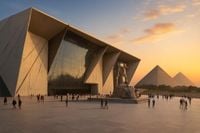On a bright November day in Giza, Egypt, the world witnessed a historic moment as the Grand Egyptian Museum (GEM) finally opened its doors to the public. The date—November 4, 2025—marks not just the unveiling of a new cultural landmark, but the realization of a grand vision decades in the making. Sitting at the edge of Cairo, within view of the legendary Pyramids, the museum stands as a gleaming testament to Egypt’s enduring fascination with its ancient past and its hopes for a vibrant future.
The opening ceremony itself was a spectacle, drawing royals and heads of state from around the globe. According to the Associated Press, the event was nothing short of extravagant, befitting a project that has been promoted as the world’s largest museum dedicated to a single civilization. With a staggering price tag of $1 billion, the GEM isn’t just another museum—it’s a megaproject, one that aspires to reshape Egypt’s cultural and economic landscape.
Walking through the museum’s vast halls on opening day, visitors were greeted by a dazzling array of artifacts—nearly 50,000 in total, according to multiple reports from Xinhua and AP. But the true crown jewel of the collection is the gallery devoted to the legendary King Tutankhamun. For the first time ever, all the treasures from the boy pharaoh’s tomb, discovered in 1922, are displayed together under one roof. It’s a sight that’s left many visitors awestruck. "It was amazing, especially the mask," said Nikolas Voulgarakis, a tourist from Greece, marveling at the iconic golden mask that has captivated imaginations for generations.
But the Tutankhamun gallery is just one highlight of a museum filled with wonders. Tourists on opening day flocked to see gilded coffins, funerary couches, gilded shrines, and the gilded throne of the young king. The museum also features the imposing colossus of Ramses II and King Khufu’s solar boat, each artifact meticulously displayed to give visitors a sense of the grandeur and mystery of ancient Egypt. As Xinhua reported, the museum showcases numerous treasures related to the civilization’s long and storied history, from everyday objects to the most elaborate burial goods.
Ahmed Ghoneim, the museum’s CEO, spoke to the significance of bringing these treasures together. “Most Tutankhamun treasures were in the old Egyptian museum,” Ghoneim told reporters, as quoted by AP. “However, some were scattered in other museums and others were kept in storage. Bringing all those treasures in one place enriches the museum display experience.” It’s a point that resonates with anyone who has ever wandered through the old, crowded halls of Cairo’s Egyptian Museum, where the treasures of Tutankhamun were once divided and, in some cases, hidden away from public view.
The new museum’s location is itself symbolic. Nestled near the base of the Giza plateau, with the pyramids looming in the distance, the GEM bridges the ancient and the modern. It invites visitors to contemplate the sweep of Egyptian history, from the earliest dynasties to the present day. The design of the museum—spacious, light-filled, and cutting-edge—reflects a desire to present Egypt’s heritage in a way that is both accessible and awe-inspiring.
For Egypt, the opening of the GEM is about more than cultural pride; it’s a strategic move to boost tourism and invigorate a troubled economy. Tourism has long been a vital sector for Egypt, but it has faced significant challenges in recent years, from political upheaval to the global pandemic. The government hopes that the museum will serve as a powerful draw for international visitors, many of whom have waited years for the chance to see the full Tutankhamun collection and other rare artifacts in person.
Expectations are high. Ghoneim told reporters that the museum anticipates 7 million visitors annually, with a daily cap of 20,000 to ensure that each guest has a smooth and enjoyable experience. That’s a bold goal, but one that seems achievable given the global fascination with ancient Egypt and the sheer scale of the museum’s offerings. As Xinhua noted, tourists on opening day were already lining up to snap photos of the golden mask, the gilded throne, and other treasures that have rarely, if ever, been displayed together.
The museum’s opening follows nearly two years of a “soft debut,” during which portions of the complex were accessible to visitors while work continued behind the scenes. President Abdel Fattah el-Sissi formally inaugurated the museum over the weekend, capping off years of anticipation and speculation about when the doors would finally open for good. The sense of relief and celebration was palpable among staff, officials, and guests alike.
For many Egyptians, the GEM is a source of national pride—a showcase for the achievements of their ancestors and a statement of intent about the country’s future. But it’s also a gift to the world, offering scholars, tourists, and curious minds a chance to connect with one of humanity’s most enduring civilizations. The decision to gather all of King Tutankhamun’s treasures in one place, as Ghoneim emphasized, was not just about logistics but about creating a richer, more meaningful experience for everyone who walks through the museum’s doors.
The impact of the museum is already being felt. Travel agencies are reporting a surge in interest, and local businesses near the Giza plateau are preparing for an influx of visitors. The Egyptian government is betting that the GEM will help restore the country’s reputation as a must-visit destination for culture lovers, historians, and adventurers alike. And with the eyes of the world now trained on Giza, that bet may well pay off.
Of course, the opening of the Grand Egyptian Museum is just the beginning. Officials have promised ongoing exhibitions, educational programs, and collaborations with international institutions. The hope is that the museum will not only preserve Egypt’s past but inspire future generations to explore, learn, and dream.
As the sun set over the pyramids on opening day, the mood was one of celebration and possibility. The Grand Egyptian Museum, with its vast halls and glittering treasures, stands as a monument to what can be achieved when vision, determination, and a deep respect for history come together. For visitors from around the world and for Egyptians themselves, the GEM is more than a museum—it’s a new chapter in an ancient story, waiting to be explored.


